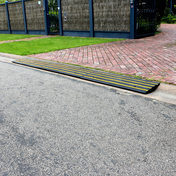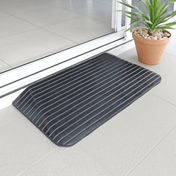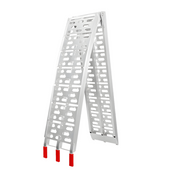When it comes to safely and efficiently loading vehicles, equipment, or machinery, choosing the right ramp is crucial. A common question we hear is: what’s the difference between curved ramps vs straight ramps, and which one is best for your needs?
Truth is, the choice between curved vs straight loading ramps really depends on factors like the type of equipment, available space, and the environment you’re working in.
They both come with a different set of benefits, making them suitable for different situations. And this is one of the first things to consider when looking for the best loading ramp for you.
In this article, we’ll dive into the curved vs straight ramps pros and cons, helping you make an informed choice. We will dive deeper into the following topics:
- Curved vs Straight Loading ramps - What’s the difference?
- The Pros and Cons of Curved Loading Ramps
- The Pros and Cons of Straight Loading Ramps
- Which is better? Curved Ramps or Straight Ramps?
So, are you ready to take notes? Let's dive in.
The Pros and Cons of Curved Loading Ramps

Curved loading ramps, also known as arched loading ramps, are designed for specific loading applications. It has a mild bend or curve designed for certain loading scenarios.
Here are some of the advantages and disadvantages of this type of ramp:
Pros of Curved Loading Ramps:
- Clearance for Low-Profile Vehicles: A key benefit of curved loading ramps is the extra clearance they provide, making them ideal for low-profile vehicles like ATVs, sports cars, and lawnmowers. The curved design helps prevent undercarriage damage by ensuring a smoother transition onto the vehicle bed.
- Even Weight Distribution: The curved design distributes the load more evenly across the ramp. This is particularly beneficial for heavy machinery, as it reduces stress on any single point of the ramp.
- Improved Traction: Curved ATV ramps and other arched loading ramps are known to offer better traction, especially on uneven or slippery surfaces. This makes them particularly useful in outdoor environments where conditions may vary.
Cons of Curved Loading Ramps:
- Storage and Deployment: Due to their arched shape, curved ramps can be bulkier to store and require more vertical space. They also tend to be less compact when compared to straight ramps.
- Higher Cost: Curved ramps often come at a higher price point due to their more complex design. If you’re on a budget, this could be a downside.
- More Space Needed: Because curved loading ramps often require additional length to reach the same height as a straight ramp, you’ll need more space to fully deploy them.
The Pros and Cons of Straight Loading Ramps

Straight ramps are a traditional and widely-used design, valued for their simplicity and versatility.
Here’s what makes them stand out, along with potential limitations:
Pros of Straight Loading Ramps:
- Versatility: Straight ramps are incredibly versatile and can be used for a wide range of loading situations. Whether it’s trucks, trailers, or heavier machinery, straight ramps adapt well to different tasks.
- Space-Saving: Unlike curved ramps, straight ramps are more compact when stored and require less space to deploy, making them a better choice for tight loading areas.
- Cost-Effective: One of the most appealing aspects of straight ramps is their affordability. If you’re after a reliable, cost-effective ramp, a straight design will usually offer the best value.
Cons of Straight Loading Ramps:
- Less Clearance: Straight ramps do not provide the same undercarriage clearance as curved loading ramps, making them less ideal for low-profile vehicles. The possibility of scraping the underside of the vehicle is greater.
- Weight Distribution: Unlike curved ramps, straight ramps may not distribute weight as evenly; thus, increasing the amount of stress on certain points of the ramp when heavier loads are handled.
So, Which is Better: Curved or Straight Ramps?
So to answer the question, “Which is better between curved ramps vs straight ramps?” it all comes down to considering your specific needs. You get what floats your boat or in this case, what loads your vehicle safely and easily.
If you’re frequently loading low-profile vehicles or require even weight distribution, curved loading ramps are likely the better option.
On the other hand, if you need a versatile, space-saving, and budget-friendly solution, straight ramps will come in handy. They are suitable for average-sized vehicles and equipment that do not need extra overhead clearance afforded by curved loading ramps.

At Ramp Champ, we offer a wide selection of curved and straight loading ramps, all designed for safety, durability, and efficiency.
Not sure which ramp suits you best? Our team is here to help! Reach out to us for personalised advice on your loading needs.






3 comments
Hi Sean,
Our 3-meter ramp (SKU: H0040) folds in half, making it easy to carry and store. We also offer other folding ramps with a higher capacity that are more compact. For further information, please feel free to contact us via email at hello@rampchamp.com.au or give us a call at 1300 913 047.
Do the 3mt straight ramps fold, 3mts×400,500kgs.Regards.
GREAT INFORMATION ON TYPES OF RAMPS